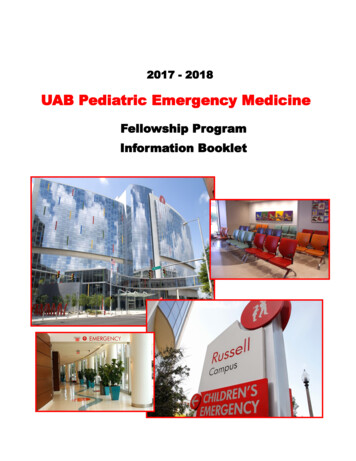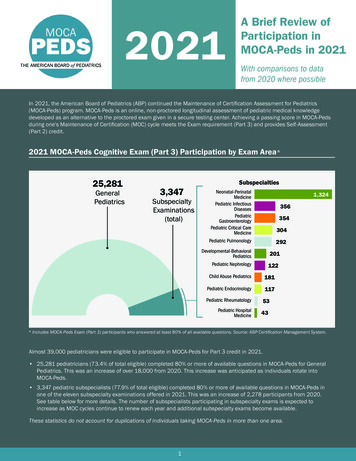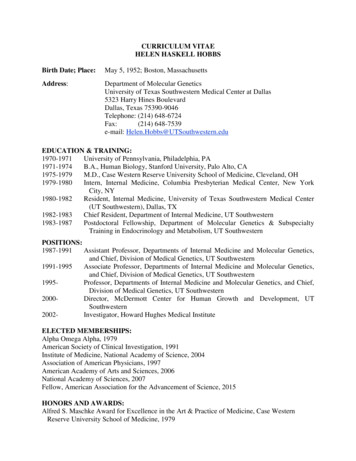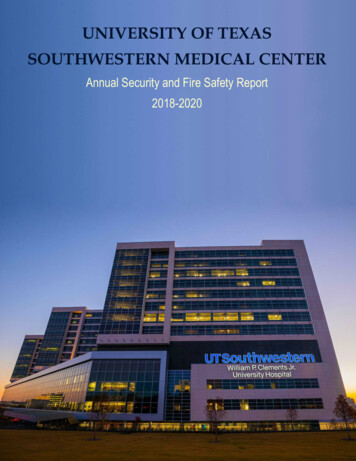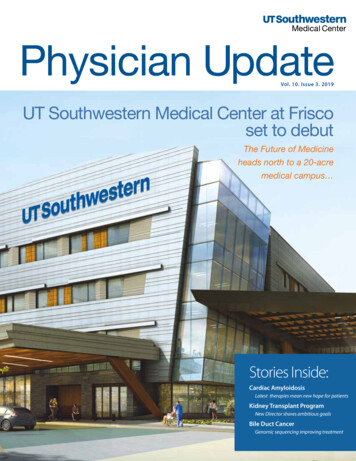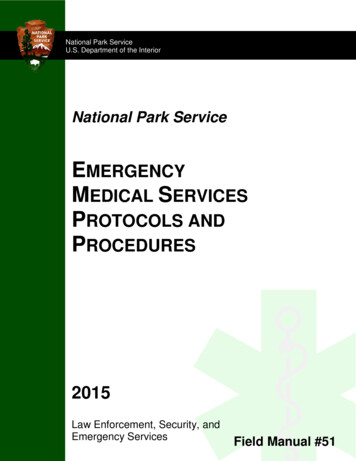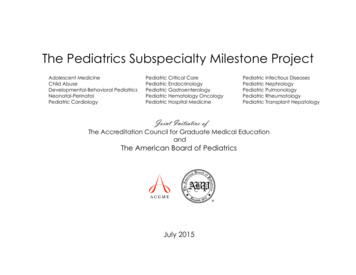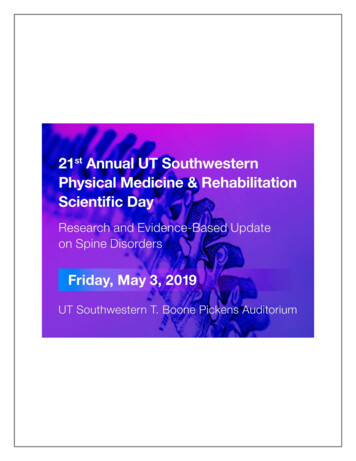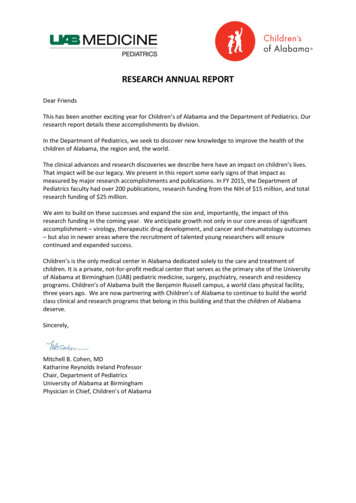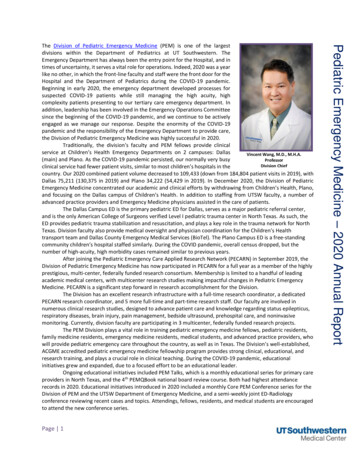
Transcription
Page 1Pediatric Emergency Medicine – 2020 Annual ReportThe Division of Pediatric Emergency Medicine (PEM) is one of the largestdivisions within the Department of Pediatrics at UT Southwestern. TheEmergency Department has always been the entry point for the Hospital, and intimes of uncertainty, it serves a vital role for operations. Indeed, 2020 was a yearlike no other, in which the front-line faculty and staff were the front door for theHospital and the Department of Pediatrics during the COVID-19 pandemic.Beginning in early 2020, the emergency department developed processes forsuspected COVID-19 patients while still managing the high acuity, highcomplexity patients presenting to our tertiary care emergency department. Inaddition, leadership has been involved in the Emergency Operations Committeesince the beginning of the COVID-19 pandemic, and we continue to be activelyengaged as we manage our response. Despite the enormity of the COVID-19pandemic and the responsibility of the Emergency Department to provide care,the Division of Pediatric Emergency Medicine was highly successful in 2020.Traditionally, the division’s faculty and PEM fellows provide clinicalservice at Children’s Health Emergency Departments on 2 campuses: DallasVincent Wang, M.D., M.H.A.(main) and Plano. As the COVID-19 pandemic persisted, our normally very busyProfessorDivision Chiefclinical service had fewer patient visits, similar to most children’s hospitals in thecountry. Our 2020 combined patient volume decreased to 109,433 (down from 184,804 patient visits in 2019), withDallas 75,211 (130,375 in 2019) and Plano 34,222 (54,429 in 2019). In December 2020, the Division of PediatricEmergency Medicine concentrated our academic and clinical efforts by withdrawing from Children’s Health, Plano,and focusing on the Dallas campus of Children’s Health. In addition to staffing from UTSW faculty, a number ofadvanced practice providers and Emergency Medicine physicians assisted in the care of patients.The Dallas Campus ED is the primary pediatric ED for Dallas, serves as a major pediatric referral center,and is the only American College of Surgeons verified Level I pediatric trauma center in North Texas. As such, theED provides pediatric trauma stabilization and resuscitation, and plays a key role in the trauma network for NorthTexas. Division faculty also provide medical oversight and physician coordination for the Children’s Healthtransport team and Dallas County Emergency Medical Services (BioTel). The Plano Campus ED is a free-standingcommunity children’s hospital staffed similarly. During the COVID pandemic, overall census dropped, but thenumber of high-acuity, high morbidity cases remained similar to previous years.After joining the Pediatric Emergency Care Applied Research Network (PECARN) in September 2019, theDivision of Pediatric Emergency Medicine has now participated in PECARN for a full year as a member of the highlyprestigious, multi-center, federally funded research consortium. Membership is limited to a handful of leadingacademic medical centers, with multicenter research studies making impactful changes in Pediatric EmergencyMedicine. PECARN is a significant step forward in research accomplishment for the Division.The Division has an excellent research infrastructure with a full-time research coordinator, a dedicatedPECARN research coordinator, and 5 more full-time and part-time research staff. Our faculty are involved innumerous clinical research studies, designed to advance patient care and knowledge regarding status epilepticus,respiratory diseases, brain injury, pain management, bedside ultrasound, prehospital care, and noninvasivemonitoring. Currently, division faculty are participating in 3 multicenter, federally funded research projects.The PEM Division plays a vital role in training pediatric emergency medicine fellows, pediatric residents,family medicine residents, emergency medicine residents, medical students, and advanced practice providers, whowill provide pediatric emergency care throughout the country, as well as in Texas. The Division’s well-established,ACGME accredited pediatric emergency medicine fellowship program provides strong clinical, educational, andresearch training, and plays a crucial role in clinical teaching. During the COVID-19 pandemic, educationalinitiatives grew and expanded, due to a focused effort to be an educational leader.Ongoing educational initiatives included PEM Talks, which is a monthly educational series for primary careproviders in North Texas, and the 4th PEMQBook national board review course. Both had highest attendancerecords in 2020. Educational initiatives introduced in 2020 included a monthly Core PEM Conference series for theDivision of PEM and the UTSW Department of Emergency Medicine, and a semi-weekly joint ED-Radiologyconference reviewing recent cases and topics. Attendings, fellows, residents, and medical students are encouragedto attend the new conference series.
Pediatric Emergency Medicine Division LeadershipVincent Wang, M.D., M.H.A.ProfessorDivision ChiefMohamed Badawy, M.D.Associate ProfessorMedical Director-DallasPamela Okada, M.D.,M.S.ProfessorMedical Director-PlanoKen Yen, M.D., M.S.Associate ProfessorCo-Research DirectorSing-Yi Feng, M.D.Associate ProfessorAssociate FellowshipDirectorCraig Huang, M.D.Associate ProfessorEMS and Trauma DirectorSusan Scott, M.D.Associate ProfessorEducation DirectorPage 2Halim Hennes, M.D., M.S.ProfessorCo-Research DirectorMegan Street, M.D.Assistant ProfessorCo-Associate MedicalDirector, DallasJo-Ann NesiamaM.D., M.S.Associate ProfessorFellowship DirectorMichael Baldovsky,D.O., M.B.A.Assistant ProfessorCo-Associate MedicalDirector, DallasReferral Nurse ProgramDirector
Division FacultyThe Division has 27 full-time and 8 part-time faculty members. Included in the group of part-time faculty membersare 3 who are full-time, but are split between other Divisions/Departments.Jonathan Nielson, MD, is 50/50 PEM and Emergency Medicine with the Department of Emergency Medicine atUTSW.Shahid Nadeem, MBBS, is primarily PEM with a secondary appointment in the Division of Pediatric Nephrology.Clay Yaklin, MD, is primarily PEM with a secondary appointment in the Division of Palliative Care.There are 12 fellows, all with diverse research and administrative interests. Five faculty joined the Division in 2020.Shahid Nadeem, MBBS, FAAPAssistant ProfessorM.B.B.S.Allama Iqbal Medical College, Lahore, Pakistan 2004Postdoctoral TrainingResidency, PediatricsWest Virginia University, Charleston, WV, 2009 – 2011Fellowship, Pediatric NephrologyEmory University, 2011 – 2014Fellowship, Pediatric Emergency MedicineUT Southwestern, 2017 – 2020Interests:Electrolyte Emergencies, Hypertension, Urinary Tract InfectionsJonathan Nielson, M.D.Assistant ProfessorM.D.Virginia Tech Carilion School of Medicine, 2015Postdoctoral TrainingResidency, Emergency MedicineVirginia Tech Carilion School of Medicine 2015 – 2018Fellowship – Pediatric Emergency MedicineChildren’s Minnesota Health Partners/Regional Hospitals 2018 – 2020Interests:Resource Utilization, Pediatric Bedside Ultrasound, SimulationPage 3
Asha Tharayil, M.D.Assistant ProfessorB.A., Mathematics & ArtAustin College, Sherman TX, 2010M.D.McGovern Medical School, Houston, TX 2014Postdoctoral TrainingResidency, PediatricsUniversity of Oklahoma Health Science Center, Oklahoma City, 2014 – 2017Fellowship, Pediatric Emergency MedicineUT Southwestern, 2017 – 2020Interests:Child abuseClay Yaklin, M.D.Assistant ProfessorB.S., Biomedical Sciences, cum laudeTexas A&M University, College Station, TX, 2009M.D.University of Texas Medical Branch, Galveston, TX, 2013Postdoctoral TrainingResidency, PediatricsChildren’s Mercy Hospital – University of Missouri, Kansas City, MO, 2013 – 2016Fellowship, Pediatric Emergency MedicineChildren’s Mercy Hospital – University of Missouri, Kansas City, MO, 2016 – 2019Fellowship, Pediatric Hospice and Palliative Care FellowshipWashington University, St. Louis, MO, 2019 – 2020Interests:Intersection of Pediatric Emergency Medicine and Palliative MedicineJillian McAdams, M.D.Assistant ProfessorB.A., Psychology/Pre-Healing Arts,Franklin & Marshall College, Lancaster, PA, 2004M.D.Virginia Commonwealth University (VCU) School of Medicine, Richmond, VA, 2010Postdoctoral TrainingResidency, PediatricsUniversity of South Carolina, Greenville, SC, 2010 – 2012Residency, PediatricsSt. Louis University School of Medicine, St. Louis, MO, 2013 – 2014Interests:Digital Innovation, Electronic Health Records, EPIC, Medical Education, Operations,Pediatric Urgent Care, TelemedicinePage 4
Honors / AwardsMohamed Badawy, MD Certificate of Recognition UT Southwestern Medical Center, Pediatric Emergency Medicine Fellowship Program,Dallas, Texas 2020 Pediatric Emergency Medicine Residency Teaching Award 2020Pamela Okada, MD Pediatric Emergency Medicine Residency Teaching Award 2020Megan Street, MD Pediatric Emergency Medicine Faculty Recognition Award 2020Ngoc “Kim” Van Horn, MD Pediatric Emergency Medicine Residency Teaching Award 2020Invited LecturesSing-Yi Feng, MD Toxicology Historical Society North American Congress of Clinical Toxicologists, San Francisco, CA. September 2020“Toxicology in Classical Music”Pamela Okada, MD, MS The National Pediatric Emergency Medicine Fellows’ Conference, Denver, CO. February 2020“ED Shift, Kids, Eat, Sleep, Repeat: Life-Work Balance”Pediatric Emergency Medicine Virtual Shadowing National Online Collaboration, (Virtual) August 2020Megan Street, MD 2020 Pediatrics Video Board Review. Sponsored by MedStudy.com. September 2020“Emergency Medicine and Maltreatment Syndrome.”Vincent J. Wang, MD Pediatric Urgent Care Conference, Los Angeles, CA, sponsored by PM Pediatrics. February 2020“Toxicological Emergencies” Pediatric Grand Rounds, UT Southwestern Medical Center, Dallas, TX, February 2020“Management of Fever in the Neonate and Young Infant” 52nd Annual Kenneth C. Haltalin Pediatrics for the Practitioner, virtual conference, October 2020“Common Pediatric Emergencies”Page 5
Conference PresentationsCelebration of Women in Medicine and ScienceUT Southwestern, Dallas, TX, February 2020Deramo J, Vandiver K, Street M, Van Horn NPoster Presentation, “Management of the Previously Healthy Neonate with Skin and Soft Tissue Infection in HighMRSA Prevalence Population”Van Horn NPoster Presentation, “Prospective evaluation on parental and staff satisfaction with the use of an EmergencyDepartment Subcutaneous Rehydration Clinical Practice Guideline”PEMQBook Board Review Course 2021Virtual National Conference, sponsored by PEMQBook, LLC. December 2020Course Co-Directors: Pamela Okada, MD, MS and Craig Huang, MDCourse Associate Director: Sing-Yi Feng, MDMohamed Badawy, MDLecture, “Trauma: Abdominal & Genitourinary”Sing-Yi Feng, MDLecture, “Environmental Emergencies”Craig Huang, MDLecture, “Pediatric Gynecology and Obstetrics”Pamela Okada, MD, MSLecture, “Medical Emergencies: Neurology”David Rodriguez, MDLecture, “Medical Emergencies: Rheumatology”Susan Scott, MDLecture, “Metabolic Emergencies: Inborn Errors of Metabolism”Megan Street, MDLecture, “Medical Emergencies: Hematology and Oncology”Vincent J. Wang, MDLecture, “Improving Test Performance”Other ConferencesCooper MTexas College of Emergency Physicians Conference, Virtual, May 2020Page 6
Poster Presentation, “Point-of-care Ultrasonography by Novice Medical Students for Detecting Inferior Vena CavaDiameter and Collapsibility and Overall Left Ventricular Function in Euvolemic Pediatric Patients”Nadeem S, Oke O, Badawy M, Filkins L, Park J, Hennes HAcademic Pediatric Association, Virtual, July 2020Virtual Presentation: “Association of Pyuria with Certain Uropathogens in Young Children”Education and TrainingThe Division of Pediatric Emergency Medicine provides educational opportunities for medical students, residents, andadvanced practice providers, in addition to its fully accredited fellowship program. Education is a group effort with multipleleaders.Even with the COVID-19 pandemic, the Division of Pediatric Emergency Medicine continued to grow educational efforts andinitiatives. Transitioning to a virtual format due to the COVID-19 pandemic accelerated our growth, and attendance expanded.Our educational activities include didactic lectures covering the core PEM curriculum, simulation labs for enhancing clinicaland procedural skills, small group discussions, bedside teaching in the ED, and Pediatric Advanced Life Support (PALS). Twonew conference series were initiated in 2020, as noted below.Beginning in July 2020, in collaboration with the Division of Pediatric Radiology, the ED started holding semi-weekly joint EDRadiology conferences, reviewing interesting recent cases and topics. Attendings, fellows, residents, and medical studentsare encouraged to attend this focused educational conference.Beginning in September 2020, a new, monthly didactic series titled “Core PEM Conferences” was initiated. The purpose ofthis lecture series is to complete the Pediatric Emergency Medicine clinical lecture curriculum over 2 years, and is nowrequired attendance for all faculty and fellows. The topics are also of relevance to the UTSW Emergency Medicine faculty,who work shifts at Children’s Medical Center, as well as the Advanced Practice Providers in the ED.In 2020, the faculty members from the Division of Pediatric Emergency Medicine sponsored the 4th national PediatricEmergency Medicine Question Review Book Board Review Conference, which is the largest board review conference in thecountry. Through this conference, faculty at UTSW helped teach the newest Pediatric Emergency Medicine attendingphysicians to pass the American Board of Pediatrics Pediatric Emergency Medicine Board certification examination. The last3 national conferences were held live and in person in 2015, 2017, and 2019. As with most conferences this year, the coursewas held virtually, and had the highest attendance ever, with 115 participants attending from throughout the country, fromthe West Coast to New England to Florida. The typical 3-day course was divided into 1-day sessions in December 2020, January2021, and February 2021.The Division of Pediatric Emergency Medicine has been giving “PEM Talks” (Plano Emergency Medicine Talks) since2018. PEM Talks was originally developed to offer education on various pediatric emergency medicine topics for the localprimary care providers in the Plano area. Monthly lectures were offered in person in the main conference room in Children’sHealth, Plano. After a brief pause due to the COVID-19 pandemic, conferences transitioned to virtual conferences. With thischange, attendance grew both in number and in catchment area, with average attendance pre-COVID being 40 (range 12 –62) in-person attendees, to average virtual attendance during COVID being 202 (range 69 – 950). Primary care providers,advanced practice providers, and nurses from all over North Texas are now attending, with attendance recorded fromOklahoma, Georgia, Ohio, Iowa, New Mexico, North Carolina, Massachusetts, and even Ontario, Canada. These talksdemonstrate the essential role of the Division of Pediatric Emergency Medicine as an educational leader in North Texas andbeyond. This evolution resulted in the conference series title being changed to Pediatric Emergency Medicine Talks, which isnow based out of the media studio at Children’s Health, Dallas. Dr. Pamela Okada continues to organize these conferences,which are given primarily by UTSW faculty. In 2020, PEM Talks lectures given by the faculty from the Division of PediatricEmergency Medicine at UTSW are as follows:Page 7
Sing-Yi Feng, MDKalpesh Patel, MDMohamed Badawy, MDCraig Huang, MDMayJuneJulyAugustMichael Baldovsky, DO, MBAAugustVincent J. Wang, MD, MHASusan Scott, MDSeptemberOctoberBiological and Chemical Terrorism in ChildrenLaceration BasicsBlunt Abdominal Trauma in ChildrenIs it Macular, Papular, Maculopapular, Or Something Else?: A PediatricEM Doctor’s Guide to RashesToo Hot, Too Cold, Too High: Heat, Cold, and Altitude Related Illness inChildrenManagement of Fever in the Neonate and Young InfantOffice PreparednessMedical StudentsThe Pediatric Emergency Medicine faculty and fellows are active in providing didactic education to UT Southwestern medicalstudents. The Division offers a third-year medical student shadowing rotation and a fourth-year medical student clerkshipthat provides in-depth exposure to Pediatric Emergency Medicine through recognition, evaluation, and management of theacutely ill and injured child.In 2020, we expanded and revised the medical student curriculum. Gordon Bruce, MD, PhD, was appointed medical studentliaison, and along with Jennifer McConnell, MD; Kim Van Horn, MD; David Rodriguez, MD; and Kayleigh McBride, DO, thefollowing changes were made: Second and third-year medical students’ experiences transformed from exclusive shadowing to a combination ofshadowing and direct patient management, including multiple case history and physical examination presentationson patients in the ED, directly supervised by attending physicians.Second and third-year medical students were issued a “passport” to guide and document their experience in thepediatric ED. The passport is similar to a travel passport with the various patient experiences documented in thebooklet. Several pages are shown below.Fourth year medical students’ clerkship experiences were divided between the moderate and higher acuity areas.Previously guided by the senior pediatric resident, the students directly present to the attending physician on thehigh acuity team.Page 8
ResidentsMajor internal educational activities include didactic lectures for the Pediatric residents, as well as Family Medicine andEmergency Medicine residents. Training in the emergency department is often sought by residents from other pediatrictraining programs in Texas and Oklahoma.The objectives of the rotation and educational efforts are to: Recognize, evaluate, and manage acutely ill and injured pediatric patientsEvaluate and manage common pediatric complaints and disease processesMaster technical skills, including lumbar puncture, laceration repair, fracture care and splinting, foreign bodyremoval, and incision and drainageAcquire and maintain efficiency and prioritization required to care for multiple patients simultaneouslyRequirements for this course include: Core competencies: common complaints, disease processes, and technical skillsMonthly patient lists: chief complaint and diagnosisNoon and monthly emergency medicine conferences and Grand RoundsEducation opportunities include: Pediatric Emergency Medicine lectures at residents’ conferences (variable over the year)Weekly didactic lectures on various Pediatric Emergency Medicine topics (every Wednesday)Pediatric Emergency Medicine Core Lectures (2nd Tuesdays)Joint Emergency Medicine-Radiology Conferences (every Monday and Thursday)Participation at Pediatric Emergency Medicine Fellows’ Meetings (every Tuesday)Bedside teaching on the diverse patient populationFellowsThe well-established Pediatric Emergency Medicine Fellowship Program accepts both pediatric- and emergency medicinetrained residents. In 2020, our first emergency medicine trained fellow (Dr. McElroy-Wallace) joined the division, along withour first EM/PEM trained attending physician, as noted in the faculty section. The program provides excellent clinical training,includes a comprehensive research curriculum with didactic teaching that covers basic research concepts and statistics, andsupports an extensive teaching curriculum to promote their individual growth as educators. The program strives to preparethe fellows to be outstanding clinician-educators, while training them to lead our future in pediatric emergency medicine, asthey are also encouraged to complete 2 research projects by graduation. As Drs. Jo-Ann Nesiama and Sing-Yi Feng haveassumed leadership of the fellowship program in July 2020, new initiatives were begun as we continue to strive for excellence.Division faculty have diverse research interests, offering the fellows a unique opportunity to select the appropriate mentorwith interests that match theirs. The Research Directors and Research Council assist faculty and fellows with their researchprojects, and the Fellowship Director has a Master of Epidemiology, along with one of the Research Directors.The Division currently has 12 full-time fellows, each with diverse research and administrative interests.Page 9
Andrew Boulos, MD3nd year PEM fellowManju Korrattiyil, MD2st year PEM fellowAli McLeroy-Wallace, MD1st year PEM fellowJennifer Deramo, MD3nd year PEM fellowChief FellowJanelle McCall, MD3nd year PEM fellowMatthias Manuel, MBBS, MPH2st year PEM fellowKayleigh McBride, MD2st year PEM fellowJacqueline Bolt, MD1st year PEM fellowNoormah Mehmood, MBBS1st year PEM fellowAmit Srivastava, MD3nd year PEM fellowLyndsey van der Laan, MD, MPH2st year PEM fellowChief Fellow ElectJohn Shin, MD1st year PEM fellowResearch ActivitiesThe Division of PEM serves a diverse population with broad pediatric pathology and high acuity, providing an opportuneenvironment for clinical research. The mission of the Division is to conduct state of the art clinical research, with an emphasison improving the clinical care and outcomes of the acutely ill or injured child. The pillars of the research program in theDivision include trauma, EMS/pre-hospital management, pain management, clinical decision rules, respiratory care, andneurologic emergencies.Page 10
Because of its rich clinical service and broad research interests, the Division has been routinely selected to participate inmulticenter, national, and international level studies. The research team has a proven track record of success by becomingone of the top enrolling sites for numerous multicenter, federally funded studies.This is the 2nd year the Division has been a PECARN (the Pediatric Emergency Care Applied Research Network) center. PECARNis a federally funded research network which conducts high-priority multi-institutional research in pediatric emergencymedicine. Being selected as a PECARN site is a high honor for the Division. Since joining PECARN in September 2019, thereare 3 active PECARN studies ongoing, and 4 new funded studies to start in 2021. Dr. Halim Hennes was the PECARN Site PIthrough August 2020, and transitioned this role to Dr. Mohamed Badawy afterwards. Dr. Hennes continues to focus onPECARN in his role as Co-Research Director.New grants awarded increased from 90,772 in 2019 to 759,118 in 2020, as shown in the 1st graph below. Active grantsincreased from 287,265 in 2019 to 977,710 in 2020 as shown in the 2nd graph below:The research infrastructure includes two full-time research coordinators, 5 full-time and part-time research assistants (RAs).Research assistant support is present in the Emergency Department 16 hours per day. Research staffing is expected to growin 2021 with the addition of one full-time and one part-time RA.The Division’s Research Council reviews and oversees all PEM research. The council is led by Dr. Halim Hennes and Dr. KennethYen, the Co-Research Directors, and is composed of the Division Chief, Research Directors, Fellowship Director, AssociateFellowship Director, Research Coordinator, a member of the Emergency Medicine nursing management and education staff,and select senior PEM faculty. The PEM Research Council's purpose is to review and oversee all PEM research developmentand implementation, advising faculty interested in initiating research projects in the ED, and guiding the division researchstaff in prioritizing implementation. Dr. Kenneth Yen focuses on institution-initiated research in his role as Co-ResearchDirector.Even with the COVID-19 pandemic, the Division of Pediatric Emergency Medicine continued to grow research efforts, with 17research publications in 2020. In comparison, in 2019, the Division published 15 research articles, and in 2018, the Divisionpublished 12 research articles. Additionally, several case reports, case series, and review articles were published each year,but were not counted as the articles heretofore mentioned. See bibliography at the end of this report.Clinical ActivitiesPediatric Emergency Medicine faculty and fellows provide emergency services at Children's Health. In 2020, the Division ofPediatric Emergency Medicine also served as the entrance point for Children’s Health efforts in the COVID-19 pandemic inthe Emergency Departments in Dallas and Plano. The beginning of 2020 began with a normal, busy winter season, but as thePage 11
months progressed, our attention focused on the spreading SARS-CoV-2 infections and preparations to manage this. Overthe course of the pandemic, the ED built systems and protocols to manage the suspected, the unsuspected, and the knownCOVID-19 cases presenting to the ED. While patient census began to drop in March 2020, administrative demands preparingfor the pandemic rose considerably, and continued into 2021. Initiatives were developed with regular improvements overthe course of the pandemic. Changes in personal protective equipment, SARS-CoV-2 testing, and management of the influxof potentially ill patients from COVID-19 occurred. The faculty and nurses in the Emergency Departments have done aspectacular job navigating the unknown and building systems to protect the staff, while still providing the typical, expectedemergency care.Dr. Mohamed Badawy continues to be the Medical Director of the Dallas campus, and Drs. Megan Street and Mike Baldovskywere added as Co-Associate Medical Directors, Dallas in 2020. Dr. Pamela Okada was the Medical Director of the Planocampus. Our 2020 patient volume for both campuses was 109,433 patient visits (Dallas: 75,211 and Plano: 34,222).In Dallas, our overall ED admission rate was 13.3% (9,970).o 55% of all hospital admissions originated from the Emergency Department in 2020.o When excluding Fast Track patients, 15.7% of patients are admitted.o Among admissions, 11% (1,100/9,970) were admitted to one of the intensive care units, reflecting arelatively large number of acutely ill and injured children.In Plano, the main ED and Fast Track data are mixed.o The overall ED admission rate was 9.1% (3,098).o Among admissions, 10.8% (334/3,098) were admitted to the intensive care unitDespite the decrease in annual visits, the number of high-acuity, high morbidity patients, remained disproportionately higherin Dallas, as the lower acuity patients dropped substantially compared to the higher acuity patients: Deaths in the ED: 27 (20 in 2019, 35% increase)Critical Care patients: 1,969 (2,282 in 2019, 12% decrease)Behavioral Health patients: 2,501 (2,637 in 2019, 5% decrease)Emergency Severity Index (triage index)o ESI 4/5 (lower acuity): 32,122 in 2020 (42% of all patients) 66,886 in 2019 (51% of all patients)o ESI 1/2/3 (higher acuity): 43,089 in 2020 (58% of all patients) 63,483 in 2019 (49% of all patients)The Dallas ED is the only Level 1 pediatric trauma center in North Texas, and pre-COVID, it was one of the busiest pediatricemergency medicine clinical services in the country. Comparative 2020 data are not available at this point in time. We alsoprovide emergency care for a variety of complex problems in children with special health care needs.One pediatric emergency medicine faculty, Dr. Sing-Yi Feng, is also a board-certified toxicologist. She manages a LeadPoisoning Clinic at Children’s Health and provides toxicology consultation service at Children’s Health, Parkland MemorialHospital, and Clements University Hospital.Telemedicine ProgramThe TeleER program started in 2015 and has evolved over the past 12 months, especially as pediatric emergency visitsdropped across the nation. We currently serve 11 hospital emergency departments, and the furthest outlying hospital islocated 417 miles from Dallas. Consults were decreased in 2020.Page 12
Patient StatisticsEmergency Medicine patient visits by location by volume and length of stay by yearDallas Main Emergency Department2016Annual VolumeTrauma (Patients meeting traumacriteria)AdmissionsMedian time arrival to 372201646,5533,647131Dallas Fast Track2016Annual volumeMedian time arrival to departure(minutes)202077,469797Trauma stat activationTrauma Alert activationTrauma consultTrauma admissionAnnual volumeAdmissionsMedian time arrival to departure(minutes)201972,757835Dallas Emergency Department Trauma StatisticsPlano Emergency 704149Quality data for the campuses are also reported here. Left without being seen (LWBS) has been an area for which we haveconcentrated our improvement efforts.See the table below for comparison values between 2019 and 2020.Left Without Being SeenAnnual LWBS: DallasJanuary: DallasFebruary: DallasAnnual LWBS: PlanoJanuary: PlanoFebruary: Plano20196.7% (8,844/130,369)5.1% (616/11,999)11.2% (1,444/12,905)3.4% (1,867/54,429)1.5% (70/4,677)3.7% (198/5,303)20200.8% (595/75,211)1.8% (213/11,659)1.1% (106/9,949)0.6% (194/34,222)1.3% ( 64/4,792)0.9% (40/4,357)LWBS is a metric that is dependent on overall census and staffing. In 2020, census dropped and staffing improved. However,as shown in the table, even in January and February 2020, before the COVID pandemic began to affect our census, LWBS wasimproved to 1.8% and 1.1%, respectively in Dallas, compared to January and February of 2019 at 5.1% and 11.2%, respectively,in Dallas. Similar trends occurred in February in Plano.Page 13
Current Grant SupportMohamed Ba
Virginia Tech Carilion School of Medicine, 2015 Postdoctoral Training Residency, Emergency Medicine Virginia Tech Carilion School of Medicine 2015 - 2018 Fellowship - Pediatric Emergency Medicine Children's Minnesota Health Partners/Regional Hospitals 2018 - 2020 Interests: Resource Utilization, Pediatric Bedside Ultrasound, Simulation

